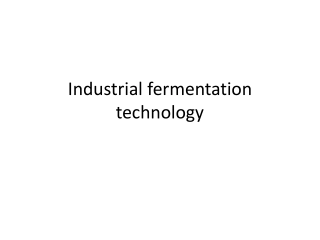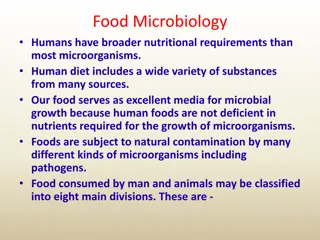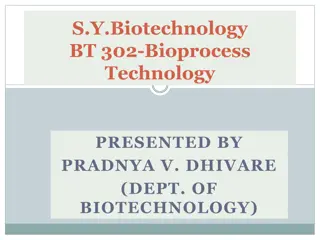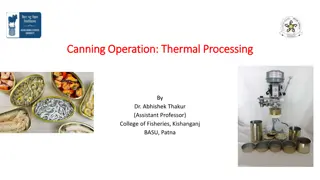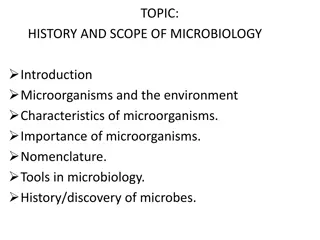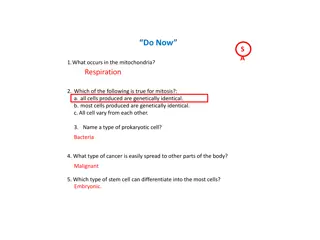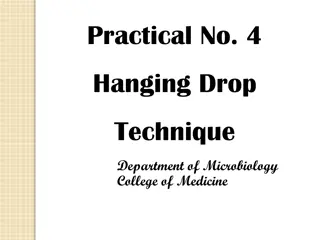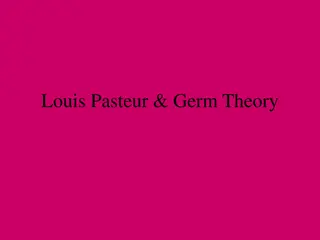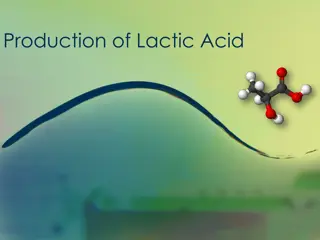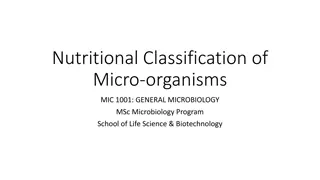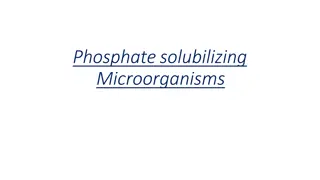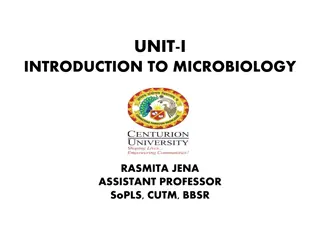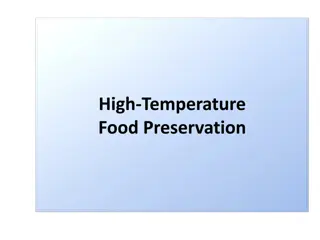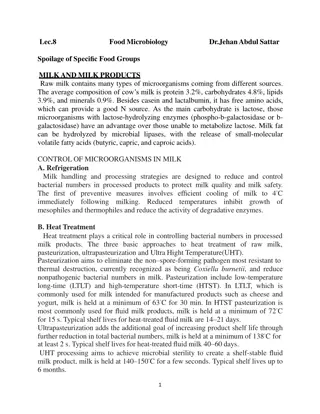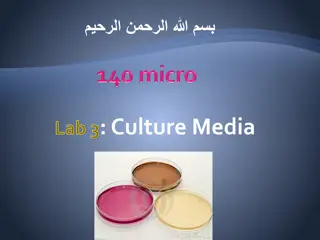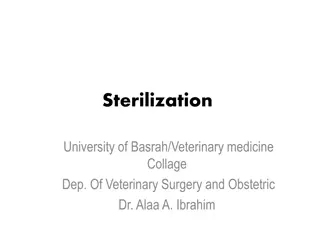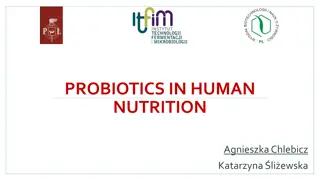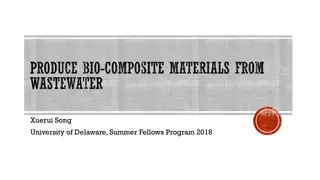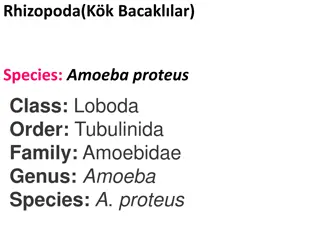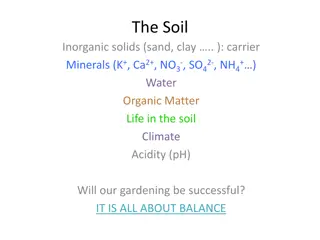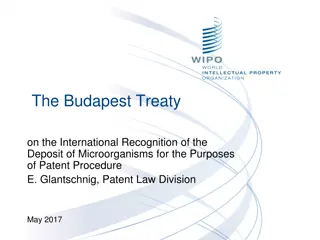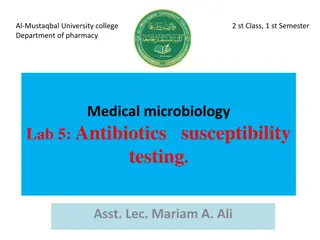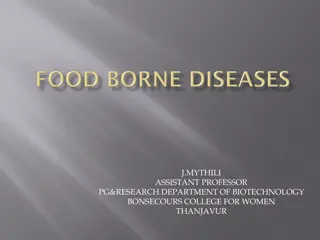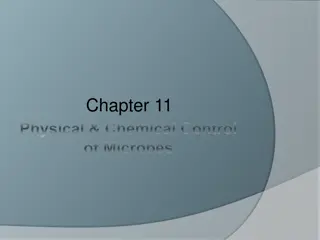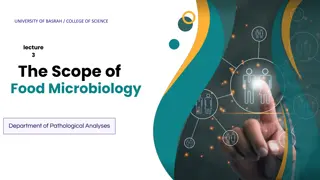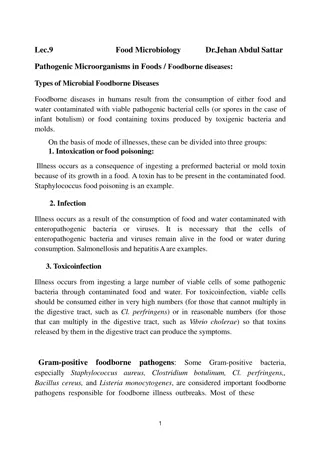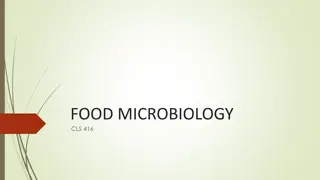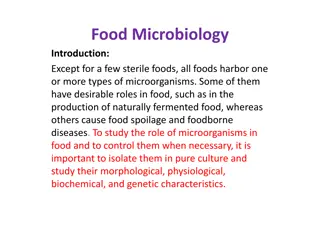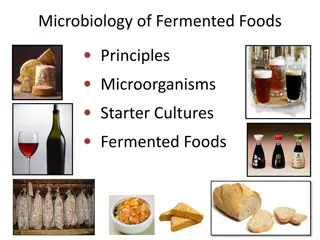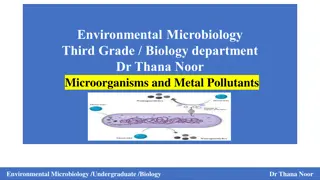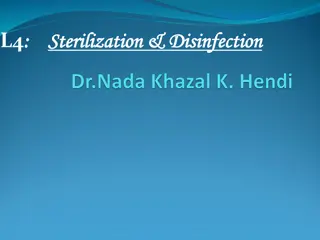Industrial fermentation technology
Industrial fermentation technology involves three key stages - Up-Stream Processing (USP), the fermentation process, and Down-Stream Processing (DSP). USP includes formulating the fermentation medium, sterilization, inoculum preparation, and improving desired microorganisms for increased productivit
1 views • 23 slides
Role of Microorganisms in Food and Industry
Microorganisms play a crucial role in the food and industrial sectors, both benefiting and causing harm. They are involved in processes such as organic compound transformation, fermentation, and food production. While beneficial microorganisms contribute to the creation of various useful food produc
5 views • 44 slides
Understanding Fungal Microorganisms and Their Impact on Human Health
Fungal microorganisms, including yeast and mold, play crucial roles in the human body's ecosystem. They can be both beneficial and harmful, influencing conditions like candidiasis and mycoses. Learn about the diverse forms and functions of eukaryotic organisms, their morphology, and the transition b
8 views • 33 slides
Overview of Industrial Biochemistry and Biotechnology
This course outline covers key topics in industrial biochemistry, microbiology, and biotechnology, focusing on the use of microorganisms and molecules to achieve specific goals in production processes. It delves into microbial physiology, genetics, metabolic pathways, enzymes, microbial growth, ferm
0 views • 10 slides
Understanding Food Microbiology: Sources of Contamination
Humans have broader nutritional requirements than most microorganisms. The human diet includes a wide variety of substances, making our food excellent media for microbial growth. Natural contamination of food by various microorganisms, including pathogens, is common. Food consumed by humans and anim
0 views • 51 slides
Understanding Bioprocess Technology and its Applications
Bioprocess technology involves utilizing living cells or their components like bacteria and enzymes to produce desired products through fermentation. This field covers a range of processes, including microbial bioprocesses, enzyme production, metabolite synthesis, recombinant products, and transform
0 views • 15 slides
Understanding Thermal Processing and Sterilization in Canning Operations
Thermal processing in canning operations involves heating sealed cans to specific time-temperature schedules to ensure consumer safety, prevent spoilage, and maintain product quality. While complete sterility is not the goal, commercial sterility is achieved to eliminate harmful microorganisms. The
2 views • 22 slides
Exploring the World of Microorganisms: History, Characteristics, and Importance
The field of Microbiology delves into the study of microorganisms, which are tiny organisms invisible to the naked eye. These microorganisms are ubiquitous in various environments, playing vital roles in processes such as food digestion, photosynthesis, and decomposition. They exhibit diverse charac
0 views • 28 slides
Safety Measures for Growing Microorganisms in the Laboratory
In the laboratory, it is crucial to use aseptic techniques when dealing with microorganisms to prevent contamination and ensure safe growth. Understanding the importance of agar plates, Petri dishes, and incubators in creating optimal conditions for microbial growth is essential. By following proper
0 views • 25 slides
Introduction to Hanging Drop Technique in Microbiology
The hanging drop technique is a method used in microbiology to observe living microorganisms suspended in a fluid under a microscope. This technique allows for the examination of motility and morphology of bacteria, providing valuable information for research and analysis. By creating a wet mount us
0 views • 17 slides
Microbiology Study: Hanging Drop Technique in Department of Microbiology, College of Medicine
In the Department of Microbiology at the College of Medicine, the Hanging Drop Technique is utilized to study live microorganisms. This technique involves suspending microorganisms in fluid on a hollow ground slide, allowing for observation of their morphology under a microscope. By creating a wet m
0 views • 8 slides
Journey to Understanding Disease Causes
Louis Pasteur's advancements in microbiology, from the discovery of microorganisms by Leeuwenhoek to the establishment of germ theory, revolutionized our understanding of disease causation. Through improved microscopes and experiments, Pasteur's work linked microorganisms to disease, setting the sta
0 views • 10 slides
Overview of Lactic Acid Production and Applications
Lactic acid occurs in two isomeric forms and has various applications in food, pharmaceuticals, and skincare industries. It is primarily produced through the fermentation of sugars by microorganisms. The production process involves using raw materials like purified sugars and agricultural wastes. Th
4 views • 11 slides
Nutritional Classification of Microorganisms in General Microbiology
Microorganisms are classified based on their nutritional requirements into autotrophs and heterotrophs. Autotrophs can utilize inorganic nutrients or light for energy, while heterotrophs require organic compounds. They are further categorized into four groups: photoautotrophs, photoheterotrophs, che
1 views • 5 slides
Microbiology Lab: The Hanging Drop Preparation
Learn how to prepare living microorganisms for microscopic study using the hanging drop technique. This method involves suspending microorganisms in a fluid and creating a hanging drop on a hollow ground slide, allowing for observation of morphology and motility. Follow step-by-step procedures to ma
0 views • 17 slides
Harnessing Phosphate-Solubilizing Microorganisms for Sustainable Crop Growth
Phosphorus is crucial for plant growth, but its availability is often limited due to insoluble forms in soil. The use of phosphate-solubilizing microorganisms (PSMs) can help convert insoluble phosphorus into a usable form for plants. This process involves isolating, screening, and mass-producing PS
0 views • 6 slides
Understanding Microbiology: An Introduction to the World of Microorganisms
Microbiology, the study of microorganisms, encompasses the history, branches, classification, and importance of microbes. From prokaryotes to eukaryotes, this field delves into the realm of tiny life forms invisible to the naked eye. Explore the rich history of microbiology, its branches, and the wi
2 views • 35 slides
Understanding the Effects of High Temperatures on Microorganisms in Food Preservation
High temperatures are utilized to preserve food by affecting microorganisms. Heating can lead to various outcomes such as heat shock, sublethal injury, or cell death in microbial cells and spores. The mechanisms of damage include loss of permeability, denaturation of key components, and inability to
0 views • 18 slides
Understanding the Diversity of Microorganisms in Soil Ecosystems
Microorganisms in soil play crucial roles in soil fertility, nutrient cycling, and industrial product synthesis. They can also be pathogens causing diseases in plants and humans. Soil organisms are broadly classified into two groups: soil flora and soil fauna, consisting of various microorganisms li
0 views • 57 slides
Controlling Microorganisms in Milk for Quality and Safety
Raw milk contains various microorganisms, and efficient cooling to 4°C post-milking is essential. Heat treatment methods like pasteurization, ultrapasteurization, and UHT processing help control bacterial numbers. Techniques such as centrifugation, filtration, and additional methods like carbon dio
0 views • 9 slides
Understanding Culture Media for Microorganisms
Culture media play a vital role in the growth and study of microorganisms. This content covers the primary ingredients required by all living organisms, types of culture media based on physical state, and specific media for bacteria and fungi. It explains the components and purposes of different typ
0 views • 24 slides
Guidelines on Sterilization, Disinfection, and Types of Disinfectants in Veterinary Medicine
Sterilization is the process of eliminating all microorganisms from an object, while disinfection reduces the number of pathogenic microorganisms on surfaces. Various types of disinfectants exist, including high-level, intermediate-level, and low-level options. Different equipment items in veterinar
0 views • 18 slides
Microorganisms: A Treasure Trove of Medicinal Compounds
Microorganisms like bacteria and fungi have been crucial in the discovery of drugs, especially antibiotics. The screening of microorganisms has led to the identification of various bioactive substances with therapeutic applications spanning from antibacterial agents to anti-cancer drugs. The success
1 views • 19 slides
Factors Affecting Microbial Growth in Foods
Moisture content and pH levels are key factors influencing the growth and survival of microorganisms in foods. The water activity (aw) of food substrates affects microbial growth, with bacteria and fungi having varying requirements. Lowering aw below optimum levels can increase the lag phase of grow
2 views • 15 slides
Understanding the Role of Probiotics in Human Nutrition
Probiotics are live microorganisms that provide health benefits when consumed in adequate amounts. They should be safe, stable, nonpathogenic, and capable of various beneficial actions such as enhancing gut integrity, detoxifying, and modulating the immune system. Probiotics have a positive impact o
0 views • 14 slides
Research on Producing Bio-Composite Materials from Wastewater Using Filamentous Bacteria and Polyhydroxyalkanoates
This project conducted at the University of Delaware aimed to evaluate the potential of using filamentous wastewater microorganisms as reinforcement and polyhydroxyalkanoates (PHA)-accumulating microorganisms as a biorenewable matrix for bio-composite materials. Filamentous bacteria were analyzed fo
1 views • 13 slides
Exploring Microorganisms: Amoeba, Radiolaria, and Sporozoa
Discover the fascinating world of microorganisms including Amoeba Proteus, Acanthometron Pellucidum, Heliosphaera Echinoides, and Plasmodium Vivax. Explore the unique characteristics and classifications of Rhizopoda, Radiolaria, and Sporozoa through detailed images and descriptions.
0 views • 24 slides
Understanding Soil Life: The Key to Successful Gardening
Soil is more than just dirt - it's a living organism teeming with microorganisms that play a crucial role in the health and fertility of your garden. Finding the right balance of aerobic and anaerobic microorganisms, organic matter, nutrients, minerals, and pH levels is essential for creating a thri
0 views • 23 slides
Understanding the Budapest Treaty on Microorganism Deposits
The Budapest Treaty on the International Recognition of the Deposit of Microorganisms for the Purposes of Patent Procedure addresses the importance of sufficient disclosure and deposit of microorganisms in patent applications. Microorganisms play crucial roles in various industries like food product
0 views • 30 slides
Understanding Antibiotic Susceptibility Testing in Medical Microbiology Lab
Antibiotics are chemical substances produced by microorganisms to inhibit or kill other microorganisms. In the lab, antibiotics susceptibility testing is conducted using the Disc Diffusion method (Kirby-Bauer method) on agar plates. The sensitivity of bacteria to antibiotics is determined by measuri
0 views • 11 slides
Understanding Food-Borne Diseases: Causes, Symptoms, and Prevention
Food-borne diseases are caused by the ingestion of contaminated food containing microorganisms or chemicals. There are two types of food infections - contaminated food acting as a carrier of microorganisms and food serving as a culture medium for pathogens. Bacteria, viruses, and parasites are commo
0 views • 20 slides
Physical and Chemical Control of Microbes
This chapter explores the methods of controlling microorganisms through sterilization, disinfection, antisepsis, and sanitization. It discusses the desired level of cleanliness, resistance of microbial forms, and various techniques used to eliminate or inhibit different types of microorganisms.
0 views • 61 slides
Insights into Airborne Microorganisms and Fungi: Implications for Food Safety
Airborne microorganisms and fungi play crucial roles in food microbiology, with various species surviving in the atmosphere despite hostile conditions. Bacteria like Bacillus and Streptomyces disperse through air turbulence, while fungi such as Penicillium and Aspergillus produce spores resistant to
0 views • 9 slides
Understanding Foodborne Diseases and Pathogenic Microorganisms in Foods
Foodborne diseases in humans are caused by consuming contaminated food or water containing pathogenic microorganisms or toxins. These diseases can be categorized into intoxication, infection, and toxicoinfection, each with distinct modes of illness. Pathogens like Staphylococcus aureus, Clostridium
0 views • 5 slides
Understanding the Impact of Microorganisms on Food
Microorganisms play a vital role in food supply, either beneficial for food bioprocessing or undesirable causing food spoilage and foodborne diseases. They can be utilized for food preservation and probiotics, but their growth and enzymatic activities can also lead to food deterioration. This articl
0 views • 9 slides
Exploring the World of Food Microbiology
The field of food microbiology delves into the intricate relationship between microorganisms and food, covering aspects such as fermentation, spoilage, and probiotics. Discoveries by pioneers like Pasteur paved the way for understanding the roles of microorganisms in food production and preservation
0 views • 21 slides
Exploring the Fascinating World of Fermented Foods and Microorganisms
Unveil the intricate world of fermented foods, delving into the principles, microorganisms, and starter cultures involved. Discover the fine balance between spoilage and fermentation, the general properties and benefits of fermented foods, and the evolution of the fermented foods industry across tim
0 views • 16 slides
The Role of Microorganisms in Mitigating Heavy Metal Pollution
Metal pollution poses health and ecological risks globally, with heavy metals like mercury and lead causing various harmful conditions. Microorganisms play a crucial role in altering the bioavailability and toxicity of metals. By converting elemental mercury to methylmercury and affecting the valenc
0 views • 9 slides
Understanding Nutritional Requirements of Microorganisms
Nutritional requirements of microorganisms play a crucial role in their growth and functionality. The essential nutrients include carbon, oxygen, iron, macroelements, micronutrients, and trace elements. Microorganisms need a balanced mixture of nutrients for biosynthesis, energy release, and various
0 views • 22 slides
Understanding Sterilization and Disinfection Methods
Sterilization involves killing all microorganisms, including bacterial spores, using physical, chemical, and mechanical methods. Disinfection, on the other hand, focuses on removing microorganisms using disinfectants. Chemical methods like antiseptics and disinfectants play a crucial role in ensurin
0 views • 18 slides
